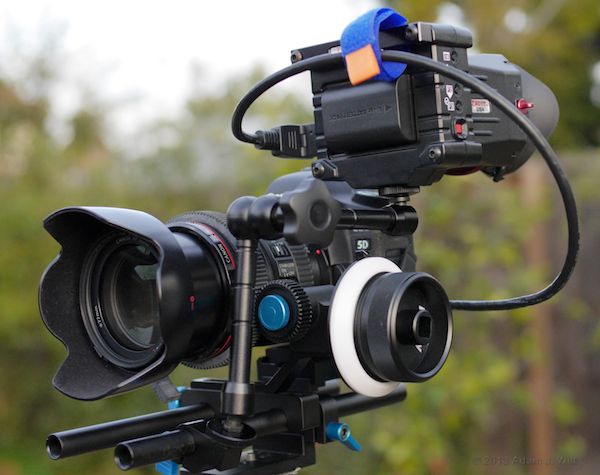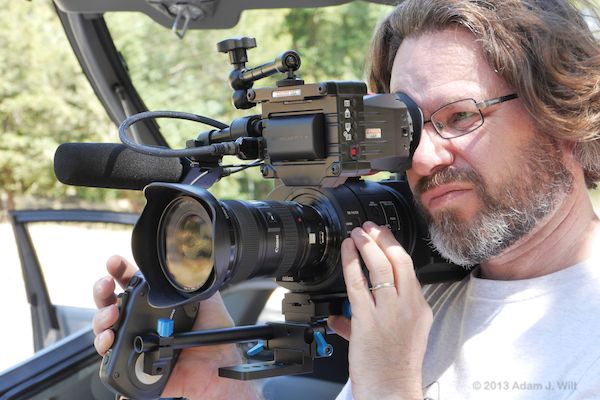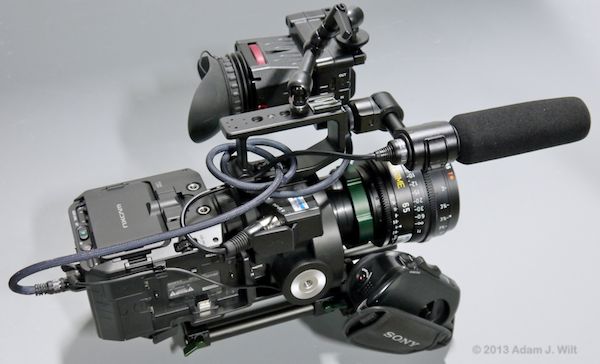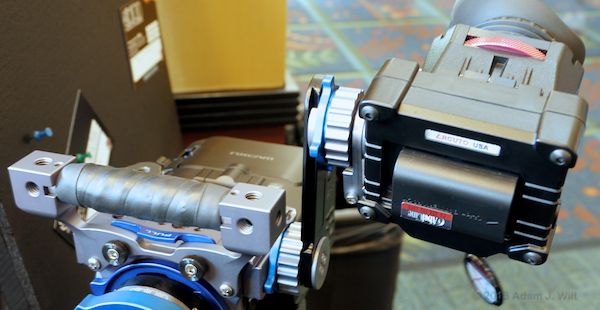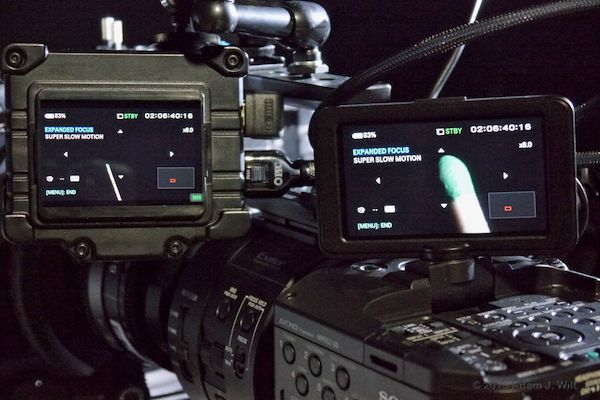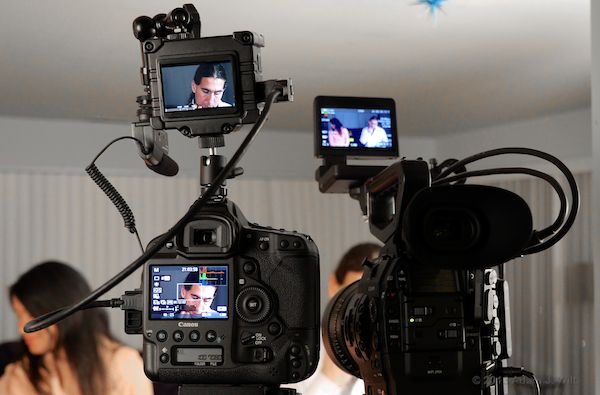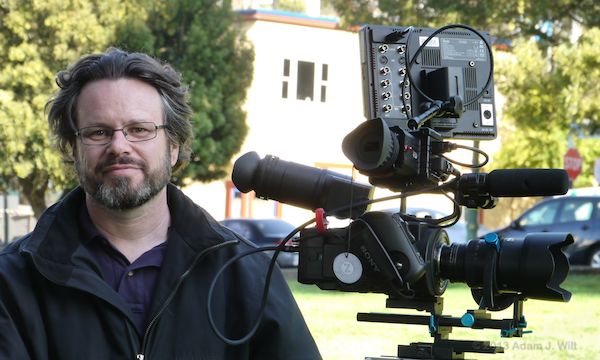Performance
The EVF uses a bright, IPS LCD screen with a resolution of 800×480. It has a glossy surface (as you can see in some of the screenshots), which allows for direct reflections but minimizes diffuse glare. It’s quite viewable, even outdoors on a sunny day.
With the eyepiece loupe fitted, be careful not to let sunlight focus on the screen though the loupe’s lens. I haven’t had this happen myself, but some people report that the screen can burn after just a few seconds. This is not unique to the EVF; many LCDs are vulnerable to sun burns, with the Canon XL1 (a standard-def DV camera from 15 years ago) first making the issue widely known. The loupe comes with a press-fit cap which I try to keep in place whenever I’m not using the finder, just to be on the safe side.
Without the eyepiece, the screen is viewable with no obvious variations in brightness, tonal scale rendering, or color within a 20 degree viewing angle. As you drift out of that sweet spot, shadow color and tone suffer slightly, but the image rendition remains fairly consistent aside from that. With the eyepiece, there’s no chance to get far enough off-axis for any variations to be seen.
The screen resolution is good for about 450 TVl/ph. Using pixel-for-pixel zooming combined with peaking or red-line focus assist, it’s tolerable for focus pulling: not great perhaps, but adequate, and better than what many DSLRs and low-end video cameras offer – consider that most such cameras don’t allow pixel-for-pixel magnification while actually recording. With the eyepiece in place (I have the 3X magnification model) the LCD’s individual pixels are visible, but it’s no worse than most LCD EVFs found on low-end HD camcorders in this regard.
Battery life is rated at 5.2 hours. In practice, I’ve always gone out the door with two charged batteries, and never had to change ’em out (I turn off the EVF between setups as a matter of habit). Today, I turned on the EVF four hours ago, to play with as I’m writing this article; it started out with three out of four bars on the battery meter, and it’s just now changed to two bars showing (and the bars have turned yellow, instead of green. It’s quite possible that when it gets to one bar, it’ll turn red, as a warning. Seriously, I’ve never had the battery get low enough to see if that happens! [Update: an hour later, the level dropped to one bar, and it did turn red. A few minutes later, the battery ran out and the EVF shut down]).
Startup time, from power on to picture shown, is about six seconds. Menu settings, stored frames, scaling modes, frame lines, and the like are remembered across power cycles and battery changes.
The housing looks like cheap plastic, but the device is rather robust: in a famous demo, Zacuto’s Steve Weiss drops the EVF from the top of a stepladder, twelve feet onto a wood floor… twice. It keeps on working (the EVF, that is; no word on the damage done to the floor). I have not had the intestinal fortitude to replicate these results myself, but my EVF has seen a few hard knocks and seems none the worse for it.
Uses
I bought this EVF because I knew I needed something for on-shoulder work with a Sony FS700, an admirable camera in many respects but one which, out of the box, defies handheld use. Here’s the thing: if one has a small, lightweight, portable, and power-stingy monitor/EVF, suddenly all sorts of applications pop up for it.
I normally don’t like cluttering up small cameras with rods ‘n’ cages ‘n’ arms ‘n’ monitors ‘n’ follow-focuses ‘n’ boat anchors ‘n’ kitchen sinks when I’m going handheld, but on a tripod, these are welcome things (well, some of them. Not sure I really need a kitchen sink). Having an EVF on an arm makes the rig much more usable as the EVF can be reoriented and repositioned as needed. And, absent the Magic Lantern hacks, a 5D doesn’t offer any focusing aids while rolling, so the focus assist modes in the EVF, limited as they are, are still very useful.
The FS100 and FS700 cameras lack usable handheld-mode viewfinders, and the Z-Finder EVF is a great help in remedying this regrettable situation. These cameras offer mounting points on the top handle, so it’s easy to use an arm to affix the EVF. This is one time when the Cheese Stick accessory is most useful; one could use the Image Flip setting and hang the EVF upside-down, but then the buttons would be on the right, next to the camera, and the cable would be on the left and have to come completely ’round the EVF on its way to the camera’s output. Trust me, the Cheese Stick is worth its minimal cost.
One problem with any single 1/4″ mounting point is that it’s easy for the EVF to spin on the mount, or for the arm to spin on the camera. Many vendors make mounting brackets for separate EVFs, like the Solid Camera mount shown above. Zacuto itself offers the $565 Axis, $330 Top Mount, and $265 Standard Mount.
One thing I didn’t anticipate when I got the Z-Finder EVF was how useful it would be as a small monitor in its own right, without the eyepiece. In the shot above, it let me view overall framing so that I could position the magnified Expanded Focus view on the FS700. I also find myself using it as a forward-facing monitor when I’m rigging lights or setting up flags (well, at least for close-in and tabletop work, where I’m close enough that a 3.2″ monitor us useful).
In this case, the Z-Finder EVF was used for two things: seeing an uncluttered image for compositional purposes while the 1DC’s LCD showed all its data readouts, and for pixel-for-pixel focus checking while shooting. I use it in a similar manner with the GH3.
On this gig, the Z-Finder EVF served me as a focus-assist monitor, on either side of the camera, and both with and without the eyepiece, so I could keep most of the shots mostly in focus (grin) for long-suffering DP/operator Art Adams. The HDMI out from the Zacuto fed a second, larger director’s monitor, too.
The Z-Finder EVF has also worked as a general utility monitor and as a feed checker: quite literally, I’ll pull it out of my pocket to check whether I’m getting a signal on a cable when setting up for a gig (it helps that the EVF briefly displays the detected video format when it sees a signal). With the protective cover snapped in place, the unit is so small, lightweight, and well-protected that I just toss it in my bag any time there’s a chance it might come in handy… and it often does. It may not be the biggest, sharpest, or most capable monitor around (and its lack of SDI I/O limits it to HDMI signals only), but just as “the best camera is the one you have with you”, the Z-Finder EVF’s extreme portability and long battery life make it the one monitor I always have with me.
Conclusion
When I got the Z-Finder EVF it was with a sense of resentful resignation: it was a have-to-have thing, not a want-to-have thing; it was sending hard-earned cash out the door just so I could see a danged picture. Harrumph.
Yet, over time, the tiny monitor in its lumpy plastic case has come in handy time and time again. It’s so darned small, so light, so robust, so stingy on power, that it’s easier to just throw it in the bag before heading out the door than to even worry about it. And if I think I might need an EVF, not just a handy utility monitor, I’ll toss the Z-Finder loupe in with it.
If I were a full-time operator? Yes, there are fancier, more capable EVFs, complete with SDI inputs and waveform monitors. Tempting… but they’re bigger and bulkier and more expensive; they’re not the sort of chuck-it-in-the-bag-just-in-case kind of gear, and they really aren’t suited for use as a compact, standalone monitor.
If I were a full-time 1st AC? Yes, there are better focusing monitors, with larger and sharper screens and better focusing aids. But they’re bigger, heavier, and more power-hungry, and they don’t do double-duty as compact EVFs. And, yeah, the good ones are considerably pricier.
But I’m not a full-time anything; I need a versatile unit that’ll work as a operator’s EVF or as a focus monitor, or as something I can just carry around in case there’s some need to look at an HDMI feed.
Sometimes a small, affordable, adaptable tool is what’s called for, and the Z-Finder EVF fills that role handily.
Pros
- Small; lightweight; lasts for-freakin’-ever on a single battery.
- Removable eyepiece: works equally well as an EVF and as a small monitor.
- Bright screen with good color rendition.
- Handles 480i, 480p, 576p, 720p, 1080i, and 1080p @ 24, 25 and 30fps.
- Decent focusing and exposure aids; audio level meters.
- Multiple DSLR scaling presets, plus ability to define your own.
- Multiple frame lines, safe markers, center cross.
- Multiple frame stores for image capture and display, with semitransparent mode.
- Anamorphic unsqueeze modes; image flip.
- HDMI passthrough; tilt-and-swivel HDMI-to-miniHDMI cable provided.
- Uses widely available Canon LP-E6 style batteries.
Cons
- No SDI input or output.
- Focusing aids aren’t as adjustable as they should be for reliable focus pulling.
- Pixel To Pixel Zoom magnifies center of screen only; it’s not repositionable.
Cautions
- Needs $30 Cheese Stick for top-mounting options.
- If you’re not careful, the LCD can get sunburned with the loupe installed.
- There are only three programmable function buttons for a ton (907 kg) of features, so you may wind up reprogramming them on every new gig (or every new setup) depending on what’s most important at the moment.
- Scaling presets also include brightness/contrast/color presets, so you may want to set scaling first, then load a brightness/contrast/color preset.
Bottom line: good things do come in small packages.
Disclosure: I bought the Zacuto Z-Finder and Z-Finder EVF Snap with my own funds for separate jobs over the past few years. Neither Zacuto nor any other vendor mentioned in the article has paid me or given me other considerations in return for a favorable mention; heck, I didn’t tell any of ’em I was doing a review, thus passing up the chance for hefty bribes (which, sadly, no one ever sees fit to offer me anyway). There is no material connection between me and Zacuto.
About the Author
 Adam Wilt is a software developer, engineering consultant, and freelance film & video tech. He’s had small jobs on big productions (PA, “Star Trek: The Motion Picture”, Dir. Robert Wise), big jobs on small productions (DP, “Maelstrom”, Dir. Rob Nilsson), and has worked camera, sound, vfx, and editing gigs on shorts, PSAs, docs, music vids, and indie features. He started his website on the DV format, www.adamwilt.com/DV.html, about the same time Chris Hurd created the XL1 Watchdog, and participated in DVInfo.net’s 2006 “Texas Shootout”. He has written for DV Magazine and ProVideoCoalition.com, taught courses at DV Expo, and given presentations at NAB, IBC, and Cine Gear Expo. When he’s not doing contract engineering or working on apps like Cine Meter, he’s probably exploring new cameras, just because cameras are fun.
Adam Wilt is a software developer, engineering consultant, and freelance film & video tech. He’s had small jobs on big productions (PA, “Star Trek: The Motion Picture”, Dir. Robert Wise), big jobs on small productions (DP, “Maelstrom”, Dir. Rob Nilsson), and has worked camera, sound, vfx, and editing gigs on shorts, PSAs, docs, music vids, and indie features. He started his website on the DV format, www.adamwilt.com/DV.html, about the same time Chris Hurd created the XL1 Watchdog, and participated in DVInfo.net’s 2006 “Texas Shootout”. He has written for DV Magazine and ProVideoCoalition.com, taught courses at DV Expo, and given presentations at NAB, IBC, and Cine Gear Expo. When he’s not doing contract engineering or working on apps like Cine Meter, he’s probably exploring new cameras, just because cameras are fun.

